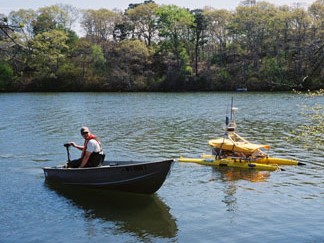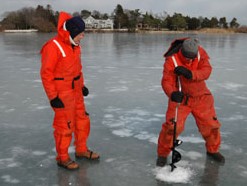Science
Additional Research at Oyster Pond
We are fortunate to be neighbors to many preeminent scientific institutions whose scientists find Oyster Pond can serve as a model site for investigating processes while also being convenient to their home institutions.
Institutions who have used Oyster Pond as a study site include the Woods Hole Oceanographic Institution, Woods Hole Coastal and Marine Science Center of the USGS, the Woodwell Climate Research Center (formally known as the Woods Hole Research Center), the Silent Spring Institute, and the Boston University Marine Program at the Marine Biological Laboratory.
Woods Hole Oceanographic and US Geological Survey
Silent Spring Institute
Silent Spring Institute is a mission-driven scientific research organization dedicated to uncovering the environmental causes of breast cancer. They discovered that hormone-disrupting chemicals such as natural estrogen and alkylphenols, as well as certain pharmaceuticals are passing through septic systems, entering the groundwater and then migrating to ponds. The researchers detected two other chemicals that indicated the presence of sewage effluent — optical brighteners, found in laundry detergents, and caffeine. Oyster Pond was one of the study sites and these compounds were detected more frequently and at higher concentrations than in ponds with less dense development. While risks to human health are yet unknown, found concentrations approach those that are have been shown to feminize fish.
Boston University and Marine Biological Laboratory Classes
Boston University Marine Program Science Projects at Oyster Pond 2001-2004
From 2001 – 2004, graduate students in the Boston University Marine Program (BUMP) Marine Ecology class under the direction of Dr. Ivan Valiela, used Oyster Pond as a study site. These research projects were undertaken to answer stakeholder concerns about the status of the Oyster Pond and its Lagoon ecosystem. Click on the each year’s links to see links to individual projects.
Woodwell Climate Research Institute
Eric Davidson of the Woods Hole Research Center (now the Woodwell Climate Research Institute) was the lead author of a study that measured how much nitrogen can enter an aquatic system via road runoff. While road runoff of nitrogen has been estimated for busy highways, few studies have looked at the impact of smaller residential roads. Nitrogen from vehicle exhaust is a source to water bodies in two ways; from atmospheric deposition and from road runoff during precipitation events. Road runoff was measured at three locations around Oyster Pond: Oyster Pond Rd, Quonset Road and Woods Hole Road. The study demonstrated that even small residential roads can accumulate significant nitrogen between precipitation events.




